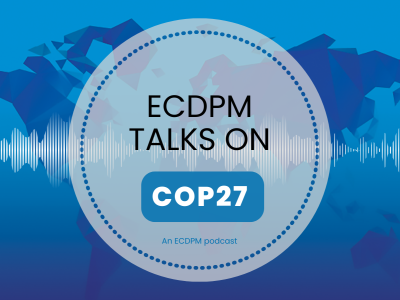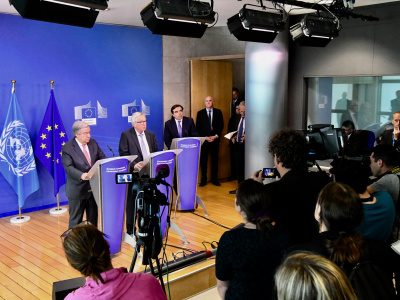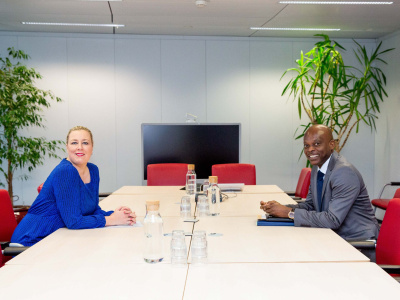
The Catalytic Role of the EU on Private Sector Investments: The Case of Climate Financing
If the EU wants to be a leader in this multi-polar world, it should increasingly incorporate climate change into its development work. Pursuing this new strategic interest and financing it runs parallel with more involvement with the private sector. However, many challenges remain to be resolved.
In recent years, the European Union’s (EU) development work has moved “beyond aid”. This has meant a shift away from just poverty reduction objectives, towards a stronger focus on policy coherence and global public goods. Climate change is a global public good par excellence: it has a cross-border dimension, in need of global solutions. However, these solutions cannot only be met by traditional donor agencies and neither can they be financed only by Official Development Assistance (ODA). Climate change should be mainstreamed into development, requiring the involvement of all sectors, all stakeholders and all budget lines. The private sector has an important role to play. The public sector should help trigger their involvement, since their investments are expected to help finance the climate change mitigation and adaptation gap.
This gap is huge, especially in Africa: the costs for adaptation are estimated at close to US$18 billion (at 2005 prices). In addition, the costs of putting Africa on a low-carbon growth path could reach US$22-30 billion per year by 2015, and US$52-68 billion per year by 2030 (1).
The urgent need to tackle climate change by all is at the top of the agenda for international high-level summits: the Elysée Summit, held in Paris in December 2013, emphasised the involvement of all parties and the importance of public and private finance in the context of climate change. Also, the upcoming EU-Africa Summit (3-4 April 2014) will broaden the dialogue on climate change between Africa and the EU (2).
Climate change is thus a good illustration of the multi-dimensional role that the European external action has to play, notably on development issues.
The EU: a catalyser in a multi-polar world?
The EU is aware of the need to adjust its strategic objectives in order to strengthen its role as an influential global development actor. The 2011 Agenda for Change (AfC) is evidence of the EU’s new development strategy. The AfC strongly emphasises leveraging private sector money. Launched in the same year, the European External Action Service (EEAS) works towards having all aspects of external policy, such as climate change under its remit.
The EU’s new aid instrument reflects this changed approach: the Multiannual Financial Framework (MFF) for the period 2014-2020 states that climate change action priorities will be mainstreamed into all the major EU funding instruments. The MFF emphasises the need for non-ODA financial instruments, with a strong involvement with the private sector (3).
Strategic partnerships are key in assuring a strong position in the multilateral climate change landscape. During the UN Climate Conference in Durban in 2011, an alliance between the EU, the Least Developed Countries (LDCs), the Alliance of Small Island States (AOSIS) and a number of Latin-American nations, allowed the EU to play a catalytic role, thereby putting pressure on the US and the emerging economies (4).
Other alliances with Africa have been institutionalised: for instance, the Joint Africa-EU Strategy (JAES) recognises their mutual interest in climate change (5).
The public sector as the risk mitigator
Alliances and strategies are crucial starting points, but fundamental changes in attitudes and practices, as well as additional substantial funds, are needed to better deal with climate change. At the Copenhagen UN Climate Conference (COP15) in 2009, industrialised countries pledged to mobilise “new and additional” funds of US$100 billion annually by 2020 to help developing countries tackle climate change (6). The private sector could be a crucial source for financing. But, to what extent is investing in climate change profitable? The challenge for the public sector is to convince the private sector to take up activities to combat climate change, thereby assuring a competitive financial return. Risk lies at the heart of private investment decisions. Public institutions should mitigate this risk.
The EU is already making use of a number of instruments to manage this risk: blending mechanisms for loans and grants, Public-Private Partnerships (PPPs), market-based insurance schemes and feed-in tariffs, in many cases provided by the European Investment Bank (EIB) (7).
These instruments have proven to be most effective in the case of mitigation projects in Africa, since there is often an easily identifiable financial return. Adaptation projects, on the other hand, provide public goods and do not directly generate revenue. Instruments, such as adaptation market mechanisms, exist, but these are still in their early stages of development. Also, some indirect instruments, such as the internalisation of adaptation costs or encouraging technology transfer for development, might be appropriate.
The EU is not singing from the same hymn sheet
Since the start of the climate negotiations, the EU has been waving the green flag, striving to lead the world on climate change in line with its norm-driven approach. However, aside from some success stories, the EU’s catalytic role has been limited. This is due to internal fragmentation. The EU’s climate change agenda is still mainly dominated by the Directorate General for Climate Action, whereas this agenda should be mainstreamed into all domains of the European Commission’s work. This calls for more coordinated action within EEAS. Making the climate change chapter of the Policy Coherence for Development (PCD) agenda more operational is also important.
Moreover, the creation of a strong coordination mechanism with more robust coalition building between the EU and other nations could prove useful. This could be an international platform with legal enforcement. Options in this regard will be top of the agenda during the 21st UN Climate Conference, to be held in Paris in 2015.
Experiences with private sector involvement are still in their infancy, showing mixed successes. In order for the EU to play a more leveraging role on the private sector, it should develop a common methodology for tracking private sector finance, including finance for adaptation (8). Clear mapping of who does what for climate financing is also required. Otherwise, it will not be possible to ensure an equitable distribution of the scarce climate finance available.
Dr. Hanne Knaepen is a Research Assistant at ECDPM.
Footnotes
1. World Bank. 2014. Climate Change. http://www.worldbank.org/en/topic/climatechange.
2. Refer to ECDPM’s work on EU-Africa Summit: Africa-Europe Relations – Looking beyond 2014. 2014. http://www.africaeu2014.blogspot.be/.
3. Financial Programming and Budget. 2014. Multiannual Financial Framework. http://ec.europa.eu/budget/mff/index_en.cfm.
Refer to ECDPM studies on private sector involvement: Byiers, B., and A. Rosengren. 2012. Common or conflicting interests? Reflections on the Private Sector (for) Development Agenda, (ECDPM Discussion Paper 131); Bilal, S, Krätke, F. 2013. Blending loans and grants for development: An effective mix for the EU? (ECDPM Briefing Note 55). Maastricht: ECDPM.
4. Gavas, M. 2013. The EU and Global Public Goods. DIIS (Danish Institute for International Studies) Report, Copenhagen.
5. Africa-EU Partnership. 2014. http://www.africa-eu-partnership.org/.
6. United Nations Framework Convention on Climate Change. 2014. Copenhagen Accord. https://unfccc.int/meetings/copenhagen_dec_2009/items/5262.php.
7. Refer to the World Resources Institute (WRI) for studies on these financial instruments: http://www.wri.org/.
8. Climate Policy Initiative. 2014. http://climatepolicyinitiative.org/.
This article was published in GREAT Insights, Volume 3, Issue 3 (March 2014)




